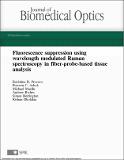Files in this item
Fluorescence suppression using wavelength modulated Raman spectroscopy in fiber-probe-based tissue analysis
Item metadata
| dc.contributor.author | Balagopal, Bavishna | |
| dc.contributor.author | Ashok, Praveen Cheriyan | |
| dc.contributor.author | Mazilu, Michael | |
| dc.contributor.author | Riches, Andrew Clive | |
| dc.contributor.author | Herrington, C Simon | |
| dc.contributor.author | Dholakia, Kishan | |
| dc.date.accessioned | 2012-12-14T16:31:01Z | |
| dc.date.available | 2012-12-14T16:31:01Z | |
| dc.date.issued | 2012-07-09 | |
| dc.identifier | 28168579 | |
| dc.identifier | e9122d30-6a34-4e9f-83ab-269179aeea37 | |
| dc.identifier | 84872031905 | |
| dc.identifier.citation | Balagopal , B , Ashok , P C , Mazilu , M , Riches , A C , Herrington , C S & Dholakia , K 2012 , ' Fluorescence suppression using wavelength modulated Raman spectroscopy in fiber-probe-based tissue analysis ' , Journal of Biomedical Optics , vol. 17 , no. 7 , 077006 . https://doi.org/10.1117/1.JBO.17.7.077006 | en |
| dc.identifier.issn | 1083-3668 | |
| dc.identifier.uri | https://hdl.handle.net/10023/3303 | |
| dc.description | The work was funded by CR-UK/EPSRC/MRC/DoH (England) imaging programme. | en |
| dc.description.abstract | In the field of biomedical optics, Raman spectroscopy is a powerful tool for probing the chemical composition of biological samples. In particular, fiber Raman probes play a crucial role for in vivo and ex vivo tissue analysis. However, the high-fluorescence background typically contributed by the auto fluorescence from both a tissue sample and the fiber-probe interferes strongly with the relatively weak Raman signal. Here we demonstrate the implementation of wavelength-modulated Raman spectroscopy (WMRS) to suppress the fluorescence background while analyzing tissues using fiber Raman probes. We have observed a significant signal-to-noise ratio enhancement in the Raman bands of bone tissue, which have a relatively high fluorescence background. Implementation of WMRS in fiber-probe-based bone tissue study yielded usable Raman spectra in a relatively short acquisition time (∼30 s), notably without any special sample preparation stage. Finally, we have validated its capability to suppress fluorescence on other tissue samples such as adipose tissue derived from four different species. | |
| dc.format.extent | 6 | |
| dc.format.extent | 1459055 | |
| dc.language.iso | eng | |
| dc.relation.ispartof | Journal of Biomedical Optics | en |
| dc.rights | Copyright (c)2012 Society of Photo-Optical Instrumentation Engineers. One print or electronic copy may be made for personal use only. Systematic reproduction and distribution, duplication of any material in this paper for a fee or for commercial purposes, or modification of the content of the paper are prohibited. | en |
| dc.subject | Biophotonics | en |
| dc.subject | Bone tissue studies | en |
| dc.subject | Raman probe | en |
| dc.subject | Raman spectroscopy | en |
| dc.subject | Tissues | en |
| dc.subject | QC Physics | en |
| dc.subject | QD Chemistry | en |
| dc.subject.lcc | QC | en |
| dc.subject.lcc | QD | en |
| dc.title | Fluorescence suppression using wavelength modulated Raman spectroscopy in fiber-probe-based tissue analysis | en |
| dc.type | Journal article | en |
| dc.contributor.sponsor | The Royal Society | en |
| dc.contributor.institution | University of St Andrews.School of Physics and Astronomy | en |
| dc.contributor.institution | University of St Andrews.School of Medicine | en |
| dc.contributor.institution | University of St Andrews.Biomedical Sciences Research Complex | en |
| dc.identifier.doi | 10.1117/1.JBO.17.7.077006 | |
| dc.description.status | Peer reviewed | en |
| dc.identifier.grantnumber | 502011.K501/NG | en |
This item appears in the following Collection(s)
Items in the St Andrews Research Repository are protected by copyright, with all rights reserved, unless otherwise indicated.

